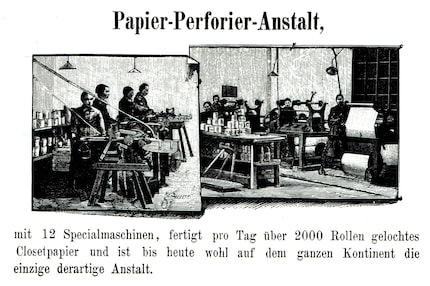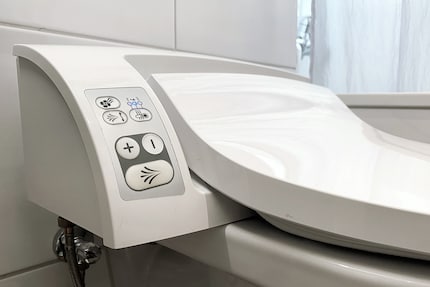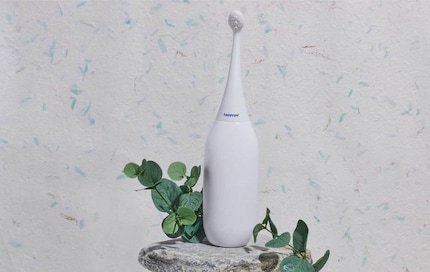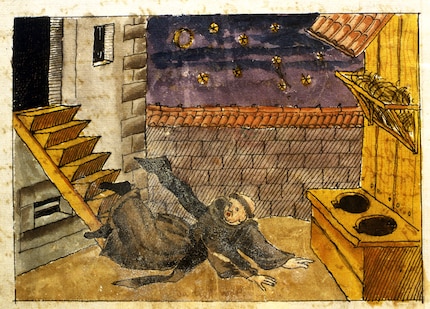
Product test
Three-week experiment: can a handheld bidet cut down my toilet paper consumption?
by Natalie Hemengül

Back when everyone was hurriedly hoarding toilet paper during the first lockdown, all I could do was smile. After all, I barely needed any of it – thanks to my shower toilet. A summary, after 5 years of use.
Humans are unique. Some are generous, others stingy; one is selfish, while another has nothing but love to give. But there is one thing we share during our day to day: we all use the toilet. Followed by cleaning any remains, of course. In this activity, however, we again differ considerably: in the West, the vast majority of people use toilet paper, while in the East most people use their hand, with water, of course. Remarkably, this status quo used to be flipped: the book «Science and Civilisation in China» mentions a traveller who, in 851, said: «They [the Chinese] don’t pay attention to cleanliness, they don’t wash with water after taking care of their deed, but wipe themselves with paper.»
The Swiss proctologist Daniel Dindo, who has had to listen to many puns featuring his last name (actually, probably only one), would put it quite similarly today: in an interview with the Tages-Anzeiger he mentioned the «strange habit of wiping our butts with dry paper». He also advises against wet wipes: «They make no sense from an ecological and financial point of view, and are often the cause of itching and other allergic reactions. Water is better. After all, it’s perfectly normal behaviour in quite a few other cultures.»

Water cleaning is also normal at Dr. Dindo’s home – he has a shower toilet. This luxurious system comes complete with heated seats, lighting and a proximity sensor that automatically lifts the lid (from around 5000 Swiss francs), or as a simple attachment for existing bowls (from 700 francs). At the push of a button, an arm extends from the unit and sprays lukewarm water upward, going back and forth. Not only does this clean faster and more thoroughly, it also removes bacteria, fungi and other delicious organisms that toilet paper can’t eliminate.

I too own a toilet nozzle, as an attachment from Geberit. But not because of Dr. Dindo. My father already bought one 10 years ago and couldn’t stop raving about it for quite some time. My mother and sister weren’t particularly interested in his enthusiastic descriptions regarding his buttocks, but I, as always, most certainly was. Even my son, still quite young at the time, was pleased just imagining the funny fountain that emerged from his grandpa’s toilet.
Then, in 2016 – I don’t know why I hesitated for so long, after all I was consuming vast amounts of wet and dry toilet paper and doing neither the environment nor my butt any favours – the time had come: I procured myself an attachment. After the plumber had installed and connected it to the water and power supply, I awaited my first try with childlike glee. Shortly thereafter, I euphorically reported to my family about how amazingly clean I now was (my mother and sister weren’t particularly interested in the descriptions, but thankfully my father is always available for this topic).
I also eloquently informed my friends about my latest acquisition and its captivating benefits: an extremely clean bottom with almost no tangible waste. After all, toilet paper is usually made from trees. Just imagine: decades-old plants are cut down, just so we can wipe our behinds with them. True, my power consumption hasn’t fallen to zero due to me still going number one, but it’s most certainly only 5% of what it was previously (which is still 1.25 kilos per head – or butt – and year at around 25 kilos). Now a pack of 12 rolls lasts me several months. Which is why, when toilet paper was sold out everywhere during the first lockdown, it didn’t cause me any distress. The two rolls I had left were easily enough until shelves were restocked.
But won’t I miss my nozzle when travelling? Every journey, without fault, I was catapulted back into the anal Middle Ages, so to speak. That was until I discovered Happy Po, a butt shower for on the go: fill it with warm water and squeeze. Fantastic!
Unfortunately, Galaxus doesn’t have it just yet, but maybe I can use my position as a writer to subtly push for this great product to be added to our range.
Until then, you can order the Happy Po here. On top of that, you can also discover a whole host of funny little texts regarding the most pressing butt topics.

Returning to my initial question on how we wiped our butts in the old days: in the course of human history, we’ve used all kinds of aids such as butterbur leaves, understandably know in Bavaria as «Arschwurzen» (assroot), as well as moss and hay. Later in the Middle Ages we moved on to textiles of all kinds, with wealthier households naturally insisting on only the noblest of fabrics. Then, from the 16th century onwards, paper was finally used. It’s still considered the be-all end-all in buttock technology, especially since its consumption is steadily increasing. But people like Dr. Dindo, my father and I who have experienced the benefits of a shower toilet know better.

Author Thomas Meyer was born in Zurich in 1974. He worked as a copywriter before publishing his first novel «The Awakening of Motti Wolkenbruch» in 2012. He's a father of one, which gives him a great excuse to buy Lego. More about Thomas: www.thomasmeyer.ch.
This is a subjective opinion of the editorial team. It doesn't necessarily reflect the position of the company.
Show all